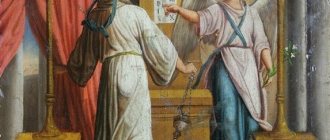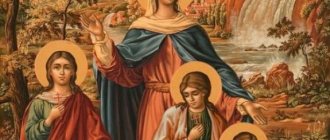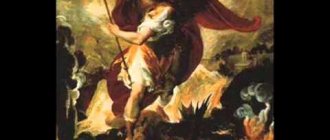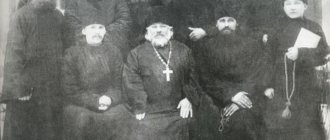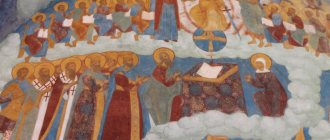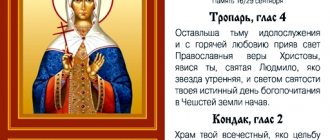St. Natalia. Fresco. Sofia Kyiv. 11th century
Until 2000, this saint was the only Natalia in the church calendar. Nowadays the Saints already number as many as six martyrs named after her. All of them also suffered for the Lord - but only in times not very long ago, during the persecutions of the 1930s and 40s. They are visible evidence that the life and deeds of the saint continue to lead people to Heaven even to this day.
Meaning of the name
It is of Latin origin, and comes from the male name Natalis (in Russian - “Nataly”), which means “native”, or generally “related to birth”. Sometimes "Natalia" is translated as "born at Christmas", since "Nativity of Christ" in Latin sounds like "Natalis Domini".
How do Christians feel about the national holiday called “Natalia Fescue Day”
This is a holiday of the folk agricultural calendar. Russian peasants, who devoutly honored the memory of the saints, could name them according to the events of the agricultural year that took place on the day of their memory. So, around September 8, they usually began harvesting oats, hence the popular name of the saint.
For many centuries, Russian peasants, who also preserved some pagan traditions, observed some customs of this kind also on St. Valentine's Day. Natalia. These were ritual actions like baking a pancake on oatmeal - berries were wrapped in it and left for the “ovinnik”, a spirit like a brownie living near the barn - a barn for drying sheaves.
Some, taking a bag, went out into the field to “seize the day,” which by this time was shortened by three hours compared to summer.
The bags were tied tightly, they “convinced” the sun to stay in the sky longer, after which they “released” the day back to the sky, while... crossing themselves three times! Of course, such actions had nothing to do with Christianity. They were generated partly by ignorance, and more by the weakness of a person who was too dependent on the elements of nature, not very accustomed to trusting himself to God.
As for the majority of modern Orthodox Christians, for them, as they live in cities and not on earth, the name “fescue” does not make sense, and various kinds of magical rituals of the day are not beneficial to the soul.
Angel's Day and Natalia's Name Day
The Orthodox calendar marks when Natasha's angel and name day is in 2022.
Three Great Martyrs Natalia are associated with January - Sundukova, Siluyanova and Vasilyeva. The first two are saints and appeared in the calendar in 2000. Based on this, these days celebrate the name days of girls who were born this year and later.
March 31 refers to another patroness - Natalya Baklanova, who was a nun in the Novodevichy Convent of the capital. When troubled times came, the girl continued to spread faith among the people. For this she was sent into exile.
The main day among name days is September 8th. In some regions of the country, oats begin to be collected from this day. That’s why Natalya got the name “fescue”. In many villages, a tradition has emerged of baking pancakes from oatmeal jelly. September is the period of weddings, and many newlyweds prefer to get married on Natalia’s name day.
The next name day is September 14, when Natalya Kozlova is venerated. In 2004 she was recognized as a saint. Patronizes girls who were born later this year. Despite the fact that she died very early, she helped the poor and disadvantaged until the last minute.
Brief Lives of the Holy Martyrs Adrian and Natalia
Information about the martyrs of the first centuries is very brief, but documented.
Their main source is the protocols of their interrogations by the authorities of Rome , who forced the saints to worship the gods. These protocols were later bought from the torturers by Christians. Later, based on them, as well as from eyewitness accounts, biographies of ascetics appeared. In the same way, we learn about the martyrdom of Saint Natalia’s husband, Adrian, who lived at the beginning of the 4th century. in Nicomedia - the capital of the eastern part of the Roman Empire. It is believed that the saint's suffering occurred between 305 and 311.
According to his life, he was a pagan, while his wife (they were married for a little over a year) believed in Christ, and also prayed deeply to bring her loved one to faith.
Mch. Adrian. Fresco from St. Sophia Cathedral in Kyiv. Ser. XI century
Once, 28-year-old Adrian, as a royal official, had the opportunity to be present during the interrogation and torture of Christian martyrs. Shocked by their firmness, he not only believed in Jesus Christ, but immediately declared himself His follower, for which he was arrested.
Having learned about this, Natalia hurried to the dungeon, where she encouraged and supported Adrian, and helped Christians exhausted from torture. It is known that many Christian women followed her example. Then the authorities forbade them to visit fellow prisoners. But when all the women retreated, Natalia dressed as a man and continued to go to her husband and his associates, bring food, and bandage wounds.
Soon all of them, starting with her husband, were executed. Natalia not only attended the execution, she herself placed her husband’s feet on the anvil, admonishing him to remain firm.
Following this, Natalia had to leave the city along with other Christians: one of the commanders asked for her hand, seeing that the woman was young, rich, and beautiful. But Natalia wished to maintain pure widowhood.
She reposed in the city of Byzantium - the future Constantinople, then a small settlement.
The Torment of St. Adriana. Tzortzi Phuka. Fresco. Athos, Dionysiatus, 1547
Types of icons
Icons of Natalia and her husband appeared first in Byzantium, then veneration moved to Russia. The Church carefully preserves the lives of the saints; their full version can be found in a special book - the Chetyi-Minea. Reading about the lives of saints is very beneficial for the soul.
Modern artists also do not forget the ancient saints - new icons of the martyr Natalia appear. She is usually depicted wearing a red cloak and a white scarf.
- The style of the image can change, but there will always be a cross in the right hand;
- The left one may contain a scarf. This is a symbol of the fact that the saint was caring for her husband - his bones were broken and he could not walk;
- The scroll is a symbol of knowledge, a personal revelation of God, which the saint comprehended.
The image of the saint can be in any room of the house. The main thing is that this place is clean and it is convenient to stand near it during prayer.
- Icon of Saint Helena
- Icon of Saint Alexandra - here
- Icon of Saint Tatiana -
What do they pray for?
Traditionally, those who have recently entered into a marriage or have been living a family life for a long time turn to saints with requests for help in arranging their family and peace in the home. The reason for this is obvious: the martyrs themselves were a truly loving couple, and also true Christians who proved their faithfulness to the Lord.
In addition, to St. Widows often turn to Natalia, especially those who lost their husbands early. Having herself experienced the death of a loved one, she, like no one else, helps and spiritually supports.
Where are the relics located?
At first they stayed in the town of Byzantium. According to the life, Natalia managed to save both the honest remains of her husband and all his fellow sufferers from desecration and send here. Later she herself moved to Byzantium, where she reposed in the Lord and was buried with Adrian.
Relics of St. Natalia in the chapel of St. Ippolita, Basilica of San Lorenzo Maggiore, Milan.
In the 7th century the relics of the saints were transferred from Constantinople to Rome, where a temple was built for them. During the reign of the fascist regime in Italy, around 1930, it was demolished. Since then, the relics at the Basilica of St. Lawrence ("San Lorenzo") of the city of Milan.
Here is how one of the modern pilgrims writes about them:
“The treasure of the ancient Basilica of San Lorenzo, which is especially dear to the hearts of Russian women, is hidden in one of the chapels behind the altar, the most modest and inconspicuous. If you don’t know in advance, you will never think that the new altar contains the relics of the holy martyr Natalia... Chapel with the relics of St. Natalia is located behind the right arch... The chapel is opened not only during prayer services, but also at individual request.”
The saint, extremely modest during her earthly life, remains so now.
Martyr Adrian and his wife Natalia. Menaion icon. Beginning XVII century (CAC MDA). Fragment
Examples of gifts
Then, when Natasha’s angel’s day and name day, you can give gifts. Presentation ideas for 2022:
- Icon. It will become a memorable gift that will provide a person with protection and patronage. You can buy it in a church shop or place an order with an icon painter. The icon embroidered from beads looks interesting.
- Musical card. A romantic girl will appreciate such a gift. The card may contain the favorite music of the hero of the occasion, which is associated with many interesting moments in life.
- Robe with a name. This is a very original gift, the birthday girl will certainly like it and will become her favorite home clothes.
Pendant with name. This is a wonderful gift for a girl. The pendant will become a favorite accessory for the hero of the occasion. The pendant can be worn both on the neck and on the wrist along with a bracelet.
Temples dedicated to martyred spouses
Now across Russia there are 16 churches and chapels dedicated to saints. Among the most famous:
- Church of Saints in the Moscow Babushkino district, near the Losinoostrovskaya railway station; the temple was built on land that was donated by the peasant Sergius Karpov, and the money for the construction itself was given by the honorary citizen of Moscow Alexander Ivanov; the church is known for the fact that it was never closed during the years of persecution, although for several years it was occupied by renovationists; the shrine of the church is a revered image of saints with particles of their relics;
The main altar, dedicated to the saints, was consecrated on April 15, 1916 by Archpriest John Vostorgov, the future hieromartyr.
- this temple is located in the area of St. Petersburg, called Staro-Panovo, on the site of a previously existing church of the same dedication; it was dedicated to the heavenly patroness of the wife of Feodor Buxhoeveden, a famous military leader who owned the estate; the church was destroyed with the beginning of the battles for Leningrad, during the Great Patriotic War; the current temple is dedicated to the memory of those killed during the blockade, as well as all the soldiers killed during the attempt to break through it - the so-called Staro-Panovskaya operation; construction began in 1996, but has only now reached the final stage; the church is being built only with public donations;
- Saratov church under construction; it has been under construction since 2015; Now there are already divine services here on Sundays and holidays, but the construction is not completed;
- the house church at the sister building of the Assumption Zilantov Monastery in Kazan; its consecration took place in 2004;
Mchch. Adrian and Natalia. Fresco from St. Sophia Cathedral in Kyiv. Ser. XI century


